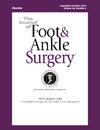糖尿病足感染严重程度作为前足部分截肢后再次溃疡的预测因素
IF 1.3
4区 医学
Q2 Medicine
引用次数: 0
摘要
糖尿病足溃疡再溃疡是前足部分截肢后常见的并发症。再溃疡指的是皮肤破损穿透表皮和部分真皮,发生在截肢的同侧或对侧足部的任何部位。糖尿病足溃疡的治疗通常包括长时间的局部伤口护理,也可能需要外科手术。本研究旨在评估前足部分截肢者再次溃疡的发生率。我们假设截肢类型与再溃疡发生率之间存在关联。我们对 2015 年 12 月至 2020 年 9 月期间的 253 人进行了回顾性病历审查。有 111 人符合资格标准,并被分为两组:再次溃疡者和未再次溃疡者。对现有的人口统计学、临床、实验室和结果数据进行了单变量分析。111 名受试者中有 79 人(71.2%)在前足部分截肢后出现再溃疡。根据美国传染病学会(IDSA)的感染评估分类,再次溃疡组的平均严重程度为 2.62,而未再次溃疡组的平均严重程度为 2.22(P<0.05)。本文章由计算机程序翻译,如有差异,请以英文原文为准。
Diabetic foot infection severity as a predictor of re-ulceration following partial forefoot amputation
Diabetic foot ulcer re-ulceration is a common complication following partial forefoot amputation. Re-ulceration refers to the occurrence of a skin break that penetrates through the epidermis and a portion of the dermis, occurring at any site on either the same or opposite foot where amputation took place. Treatment for diabetic foot ulcers often includes an extended course of local wound care and may entail surgical procedures. The aim of this study was to evaluate the incidence of re-ulceration in people who underwent a partial forefoot amputation. We hypothesized there is an association between amputation type and occurrence of re-ulceration. A retrospective chart review was performed for 253 individuals between December 2015 and September 2020. One hundred eleven people met eligibility criteria and were divided into two cohorts: those who re-ulcerated and those who did not. Univariable analysis was performed for available demographic, clinical, laboratory and outcome data. Seventy-nine of the 111 (71.2 %) subjects re-ulcerated status post partial forefoot amputation. Based on the Infectious Disease Society of America (IDSA) classification for assessment of infection, the average severity for the re-ulceration group was 2.62, while for the no re-ulceration group was 2.22 (p < 0.001). The median time to re-ulceration was 186 days. No association was demonstrated between amputation location and incidence of re-ulceration. Patients with higher diabetic foot infection severity based on IDSA classification are at greater risk for developing re-ulceration following a partial forefoot amputation.
求助全文
通过发布文献求助,成功后即可免费获取论文全文。
去求助
来源期刊

Journal of Foot & Ankle Surgery
ORTHOPEDICS-SURGERY
CiteScore
2.30
自引率
7.70%
发文量
234
审稿时长
29.8 weeks
期刊介绍:
The Journal of Foot & Ankle Surgery is the leading source for original, clinically-focused articles on the surgical and medical management of the foot and ankle. Each bi-monthly, peer-reviewed issue addresses relevant topics to the profession, such as: adult reconstruction of the forefoot; adult reconstruction of the hindfoot and ankle; diabetes; medicine/rheumatology; pediatrics; research; sports medicine; trauma; and tumors.
 求助内容:
求助内容: 应助结果提醒方式:
应助结果提醒方式:


